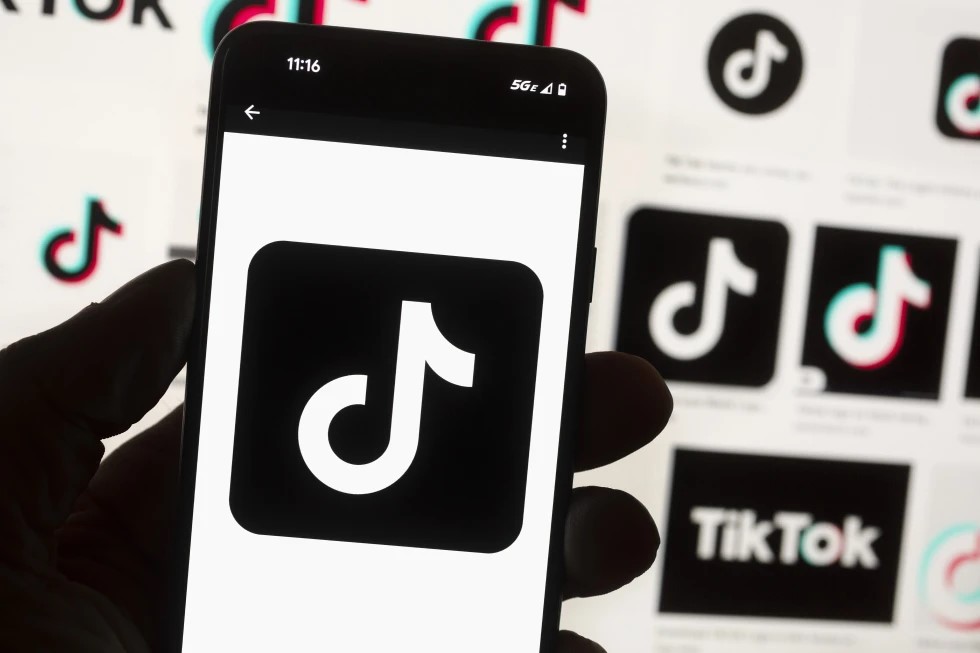
FILE – The TikTok logo is displayed on a mobile phone in front of a computer screen, Oct. 14, 2022, in Boston. TikTok will begin labeling content created using artificial intelligence when it’s uploaded from certain platforms. TikTok says its efforts are an attempt to combat misinformation from being spread on its social media platform. The announcement came on ABC’s “Good Morning America” on Thursday, May 9, 2024. (AP Photo/Michael Dwyer, File)
TikTok will begin labeling content created using artificial intelligence when it’s been uploaded from outside its own platform in an attempt to combat misinformation.
“AI enables incredible creative opportunities, but can confuse or mislead viewers if they don’t know content was AI-generated,” the company said in a prepared statement Thursday. “Labeling helps make that context clear—which is why we label AIGC made with TikTok AI effects, and have required creators to label realistic AIGC for over a year.”
TikTok’s shift in policy is part of an broader attempt in the technology industry to provide more safeguards for AI usage. In February Meta announced that it was working with industry partners on technical standards that will make it easier to identify images and eventually video and audio generated by artificial intelligence tools. Users on Facebook and Instagram users would see labels on AI-generated images.
Google said last year that AI labels are coming to YouTube and its other platforms.
A push for digital watermarking and labeling of AI-generated content was also part of an executive order that U.S. President Joe Biden signed in October.
TikTok is teaming up with the Coalition for Content Provenance and Authenticity and will use their Content Credentials technology.
The company said that the technology can attach metadata to content, which it can use to instantly recognize and label AI-generated content. TikTok said it began to deploy the technology Thursday on images and videos and will be coming to audio-only content soon.
READ: TikTok video on translating Cebuano term to English goes viral
In coming months, Content Credentials will be attached to submissions made on TikTok, which will remain on the content when downloaded. This will help identify AI-generated material that’s made on TikTok and help people learn when, where and how the content was made or edited. Other platforms that adopt Content Credentials will be able to automatically label it.
“Using Content Credentials as a way to identify and convey synthetic media to audiences directly is a meaningful step towards AI transparency, even more so than typical watermarking techniques,” Claire Leibowicz, head of the AI and Media Integrity Program at the Partnership on AI, said in a prepared statement. “At the same time we need to better understand how users react to these labels and hope that TikTok reports on the response so that we may better understand how the public navigates an increasingly AI-augmented world.”
TikTok said it’s the first video-sharing platform to put the credentials into practice and will join the Adobe-led Content Authenticity Initiative to help push the adoption of the credentials within the industry.
“TikTok is the first social media platform to support Content Credentials, and with over 170 million users in the United States alone, their platform and their vast community of creators and users are an essential piece of that chain of trust needed to increase transparency online,” Dana Rao, Adobe’s executive vice president, general counsel and chief trust officer, said in a blog post.
TikTok’s policy in the past has been to encourage users to label content that has been generated or significantly edited by AI. It also requires users to label all AI-generated content where it contains realistic images, audio, and video.
READ: PH among most TikTok-crazed countries in the world
“Our users and our creators are so excited about AI and what it can do for their creativity and their ability to connect with audiences.” Adam Presser, TikTok’s Head of Operations & Trust and Safety told ABC News. “And at the same time, we want to make sure that people have that ability to understand what fact is and what is fiction.”
The announcement initially came on ABC’s “Good Morning America” on Thursday.
TikTok’s AI actions come just two days after TikTok said that it and its Chinese parent company, ByteDance, had filed a lawsuit challenging a new American law that would ban the video-sharing app in the U.S. unless it’s sold to an approved buyer, saying it unfairly singles out the platform and is an unprecedented attack on free speech.
The lawsuit is the latest turn in what’s shaping up to be a protracted legal fight over TikTok’s future in the United States — and one that could end up before the Supreme Court. If TikTok loses, it says it would be forced to shut down next year.